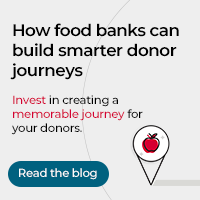Benchmark Findings
When was the last “normal” year of fundraising for food banks? We probably need to go all the way back to 2018.
Since then, we’ve seen a government shutdown (2019), a global pandemic (2020-21) and the rapid rise of inflation (2022). Each of these major events has had an economic impact on communities across the U.S. As needs increase, so does the need for food bank services, which also increases the generosity of donors.
This context is essential to understanding the story behind the numbers of our 2023 Food Bank Benchmark Report. In the data, you’ll see the following key learnings:
1. Post-COVID food banks are stronger because of the pandemic.
The dynamics of social change surrounding the COVID-19 pandemic accelerated growth for food banks, bringing humanitarian need into the spotlight and mobilizing new audiences to support local causes. This has reshaped the profile of new donors to be both younger and more digitally engaged.
2. 2020 and 2021 represent significant performance outliers.
We are witnessing the formation of new performance baselines for Food Banks post-COVID—a “new normal.” We cannot expect pandemic-level performance to be sustained, but that doesn’t mean giving should return to pre-pandemic levels either.
3. Performance trends in 2022 were similar across regions and size.
We observed similar themes of growth and transformation during the pandemic, accelerating positive file health indicators and setting food banks on a new trajectory. Organizations that leaned into fundraising by increasing campaign budgets during the pandemic saw increased brand awareness and charitable giving that allowed them to continue maximizing fundraising opportunities in 2022.
4. Retention levels should be watched closely.
Positive spikes in retention caused during the pandemic are not sustaining post-COVID. Retention and reactivation rates are softening to levels observed historically, and even lower in some cases. The introduction of a wave of new donors, along with changes to media consumption habits (more digital engagement as audiences migrate online) could have permanent effects on retention baselines.
About the Report
What we measured
The 2023 Food Bank Benchmark Report contains full-file data from 77 RKD food bank clients across the United States from Jan. 1, 2018, to Dec. 31, 2022. The data includes overall program metrics, like total revenue, active donors, new donors, retention rate, average gift size, donor value and gift frequency.
We’ve broken this data out into five regions across the U.S.: West, Southwest, Midwest, Northeast and Southeast. We’ve also categorized the data by organization size (determined by active donor file size in 2022):
- Large (10,000 or more donors)
- Mid (5,000 to 9,999 donors)
- Small (2,000 to 4,999 donors)
- Emerging (under 2,000 donors)
Trends are based on all donors and all gift types. Donors with a gift of $10,000 or more were excluded.
How to read the benchmarks
Each metric is indexed. We set 2018 as the baseline value of 100. Results in the following years are compared against 2018 and then averaged across clients, explaining the relative change in result for each benchmark over time.
Values over 100 indicate an increase over the value in 2018. Values below 100 indicate a decrease vs. the value in 2018. For example, an active donor value of 200 would represent a doubling in the number of active donors.
Overall Findings
Revenue remains strong
If you looked at an isolated view of 2020-22, you would see that revenue declined for the second straight year in 2022. But if you back out a little further, you’ll see the broader context—revenue in 2022 was still DOUBLE what it was in the years prior to the pandemic.
The COVID-19 pandemic caused donations to reach record highs in 2020. Revenue then declined slightly in 2021. As the immediate emergency of the pandemic faded in late 2021 and into 2022, the impact of rising inflation began to set in and caused giving to slow at some nonprofit organizations.
But many food banks were able to remain relevant with their donors by stressing how inflation impacted their communities. As a result, food banks finished 2022 as far healthier organizations than they were entering the pandemic.
Average gift amounts are up
The average gift across all active donors was 22% higher in 2022 than it was pre-COVID. A rise in new donor value is one thing, but existing donors are also giving larger amounts on average.
Donors are giving more often
Gift frequency has been steadily increasing over the last five years, and donors in 2022 gave 19% more frequently than pre-COVID. As a driver of healthy retention, donors giving larger gifts more often should help strengthen food banks for future years.
Average donor value reaches new heights
Donor value in 2022 exceeded pre-COVID levels by 46%. It shouldn’t be a big surprise that having donors give larger gifts more often would result in a better donor value. But food bank donors continue to demonstrate levels of generosity that we’ve typically not seen before.
All lifecycles are up in value
The rise in donor value isn’t isolated to a particular group of donors. These new giving patterns are continuing across all audiences, resulting in value growth across all donor lifecycles.
Retention is softening
Any surge in new donors inevitably leads to a decline in overall retention as those new donors move through the file. The new donors acquired in 2020 began moving into the core donor file in 2022, which saw retention decline below pre-COVID levels.
Lapsed reactivation falls below pre-COVID levels
The reactivation of both recently lapsed and deeply lapsed donors declined from the 2020 high and fell below pre-COVID levels in both 2021 and 2022. Reactivation of deeply lapsed audiences could be more difficult in the coming years since fewer audiences lapsed during COVID. To put it another way, if the pandemic didn’t spark them to give again, they’re not coming back.
Acquisition Findings
Food bank donor files are bigger
The growth in revenue above came—in large part—from a growth in donors. Food banks today have 44% more donors than they did prior to the pandemic.
Acquisition fueled donor file growth
It’s no secret that COVID-19 caused a surge in new food bank donors (2020 had four times as many new donors as the previous year). But new donor volumes continue to benefit from the expanded market reach and rise in awareness that occurred during the pandemic. In 2022, food banks saw 46% more new donors compared to 2018.
A new kind of donor emerges
Food banks began acquiring a whole new level of donor in 2020—with a first gift value 44% higher than in 2018. This softened vs. the initial surge from the pandemic, but food banks are continuing to fuel their new donor pipelines with a better mix of donor quality and value. For most orgs, this means average gifts of $100 and higher.
Acquiring more at all levels
The “new normal” for acquisition post-COVID looks strong. The expansion of new donor volumes is settling in at quantities that exceed historical pre-COVID benchmarks, especially among the highest value donors. Acquisition at every gift level was up in 2022 vs. 2018.
Regional Benchmarks
We divided the U.S. into five distinct regions to analyze how giving trends look across the country.
Regional patterns are similar across metrics
Prior to the pandemic, we often found differences in trends across regions—particularly if an area saw a disaster (like a hurricane or flood). In 2022, most performance index patterns look similar across regions. The Midwest saw the most softening compared to other regions. The Midwest also observed some of the lowest increases during COVID.
Retention and reactivation patterns are also similar
Likewise, the retention and reactivation trends look similar across regions. The Southeast region experienced the most lift in retention and is seeing the slowest softening.
Organization Size Benchmarks
We categorized the data by organization size (determined by active donor file size in 2022) to analyze how giving trends look:
- Large (10,000 or more donors)
- Mid (5,000 to 9,999 donors)
- Small (2,000 to 4,999 donors)
- Emerging (under 2,000 donors)
Large and mid-sized saw the most growth
Large and mid-sized organizations experienced the biggest lift in new donors during the pandemic. Emerging organizations have grown the least since 2018 and have the flattest trends vs. 2018 on new donor and revenue volumes. However, emerging food banks have seen the biggest lift in first gift size and gift frequency.
Small food banks show the best retention
Small food banks have maintained retention levels well. Large and emerging organizations are having more difficulty in this area. Emerging food banks also had the weakest retention rates during COVID and saw the lowest levels of reactivation.
About RKD Group
RKD Group is a leading fundraising and marketing services provider to hundreds of nonprofit organizations. With five decades of experience, RKD Group's omnichannel approach leverages technology, advanced data science and award-winning strategic and creative leadership to accelerate net revenue growth, build long-term donor relationships and drive the best return on investment. RKD Group creates breakthroughs never thought possible.
![Mollison10xPillarPageTemplate.png [This image is under extended electronic license for template purposes only. Please replace with your own image before publishing your page.] Mollison10xPillarPageTemplate.png [This image is under extended electronic license for template purposes only. Please replace with your own image before publishing your page.]](Marketplace/3P_Creative_Group/Mollison_Pillar_Page_Template/Images/Mollison10xPillarPageTemplate.png)

-1.png?width=150&height=75&name=RKD-logo-red-tm%20(1)-1.png)


